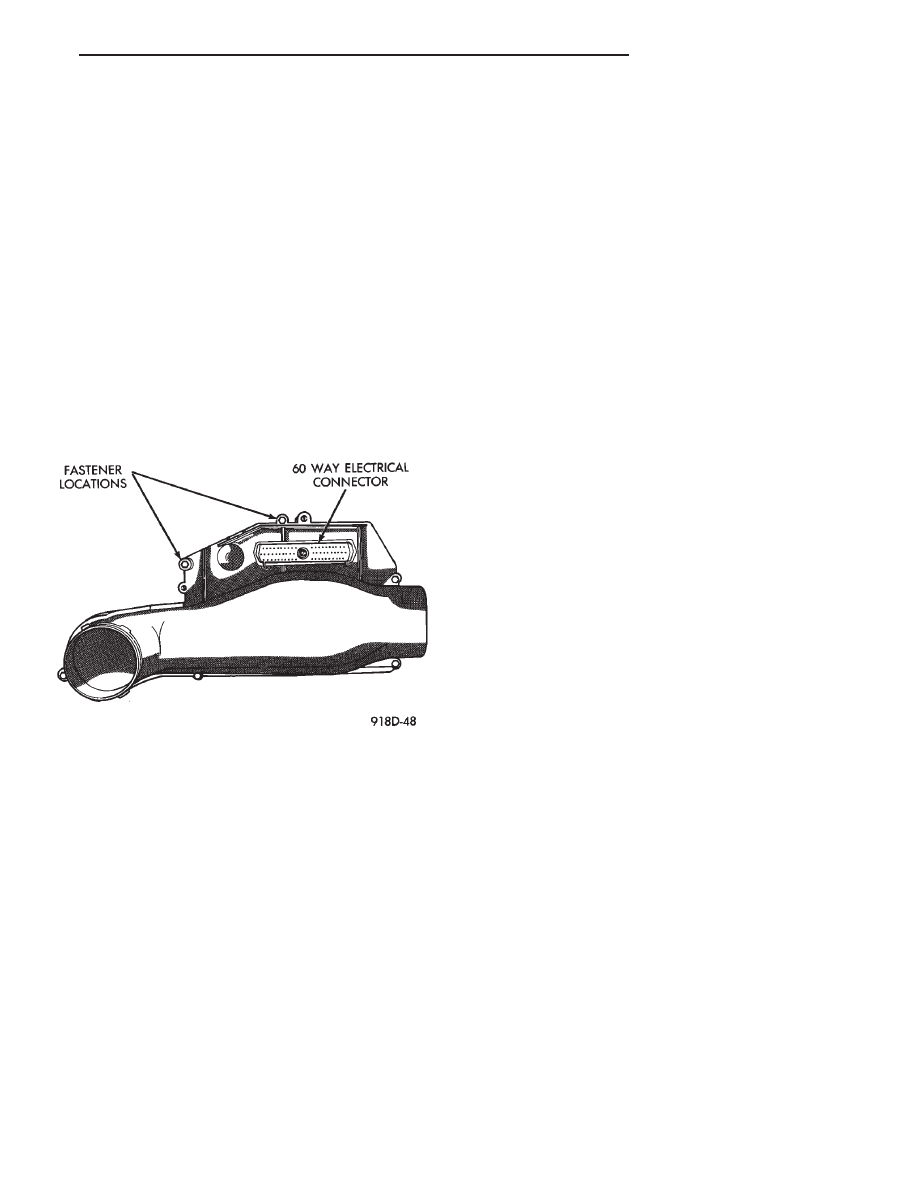Chrysler Le Baron, Dodge Dynasty, Plymouth Acclaim. Manual - part 35

The second method of reading diagnostic trouble
codes uses the DRBII scan tool. For diagnostic trou-
ble code information, refer to the On-Board Diagnos-
tics section in this group.
CCD BUS
Various modules exchange information through a
communications port called the CCD Bus. The pow-
ertrain control module transmits vehicle load data on
the CCD Bus.
POWERTRAIN CONTROL MODULE
The powertrain control module (PCM) is a digital
computer containing a microprocessor (Fig. 2). The
PCM receives input signals from various switches
and sensors referred to as Powertrain Control Mod-
ule Inputs. Based on these inputs, the PCM adjusts
various engine and vehicle operations through de-
vices referred to as Powertrain Control Module Out-
puts.
PCM Inputs:
• Air Conditioning Controls
• Battery Voltage
• Brake Switch
• Engine Coolant Temperature Sensor
• Camshaft Position Sensor (Distributor Pick-up)
• Manifold Absolute Pressure (MAP) Sensor
• Methanol Concentration Sensor
• Oxygen Sensor
• SCI Receive
• Speed Control System Controls
• Throttle Position Sensor
• Park/Neutral Switch (automatic transaxle)
• Vehicle Speed Sensor
PCM Outputs:
• Air Conditioning Clutch Relay
• Generator Field
• Auto Shutdown (ASD) Relay
• Duty Cycle EVAP Canister Purge Solenoid
• Data Link (Diagnostic) Connector
• Fuel Injectors
• Idle Air Control Motor
• Ignition Coil
• Malfunction Indicator (Check Engine) Lamp
• Radiator Fan Relay
• Speed Control Solenoids
• Tachometer Output
• Torque Converter Clutch Solenoid
Based on inputs it receives, the PCM adjusts fuel
injector pulse width, idle speed, ignition spark ad-
vance, ignition coil dwell and canister purge opera-
tion. The PCM regulates operation of the radiator
fan, A/C and speed control systems. Also, the PCM
changes generator charge rate by adjusting the gen-
erator field.
The PCM adjusts injector pulse width (air-fuel ra-
tio) based on the following inputs.
• Battery voltage
• Coolant temperature
• Exhaust gas content
• Engine speed
• Manifold absolute pressure
• Methanol percentage of fuel
• Throttle position
The PCM adjusts ignition timing based on the fol-
lowing inputs.
• Coolant temperature
• Engine speed
• Manifold absolute pressure
• Methanol percentage of fuel
• Throttle position
The auto shutdown (ASD) and fuel pump relays are
mounted externally. The PCM turns both relays on
and off through the same circuit.
The camshaft position sensor (distributor pick-up)
sends a signal to the PCM. If the PCM does not re-
ceive a camshaft position sensor signal within ap-
proximately
one
second
of
engine
cranking,
it
deactivates the ASD and fuel pump relays. When
these relays deactivate, they shut off power to the
fuel injectors, fuel pump, ignition coil, methanol con-
centration sensor and oxygen sensor heater element.
The
PCM
contains
a
voltage
converter
that
changes battery voltage to a regulated 8.0 volts to
power the distributor pick-up methanol concentration
sensor and vehicle speed sensor. The PCM also pro-
vides a 5.0 volts supply for the engine coolant tem-
perature sensor, manifold absolute pressure sensor
and throttle position sensor.
AIR CONDITIONING SWITCH SENSE—PCM INPUT
When the operator puts the A/C or defrost switch
in the ON position and the low pressure and high
pressure switches close, the PCM receives an input.
The input indicates the operator selected air condi-
tioning. After receiving this input, the PCM acti-
vates the A/C compressor clutch by grounding the
Fig. 2 Powertrain Control Module
Ä
FUEL SYSTEMS
14 - 57